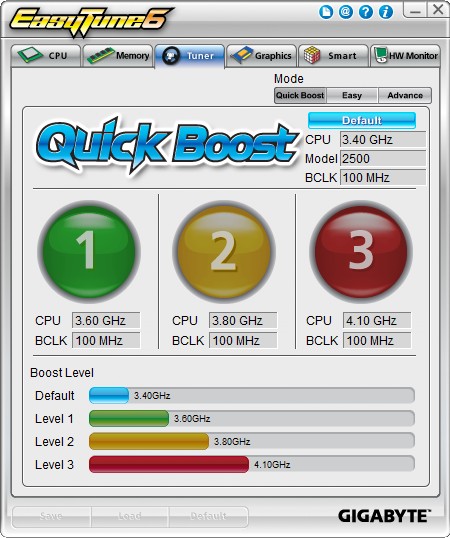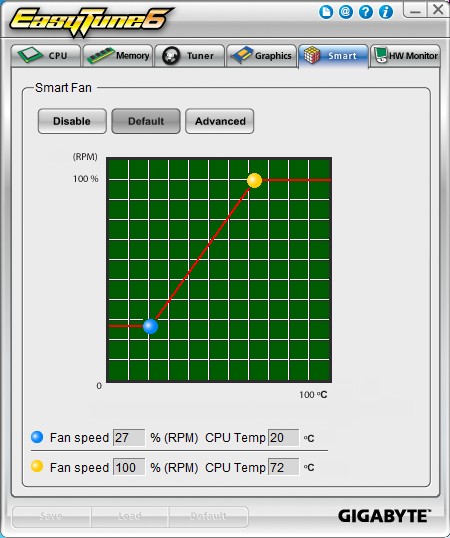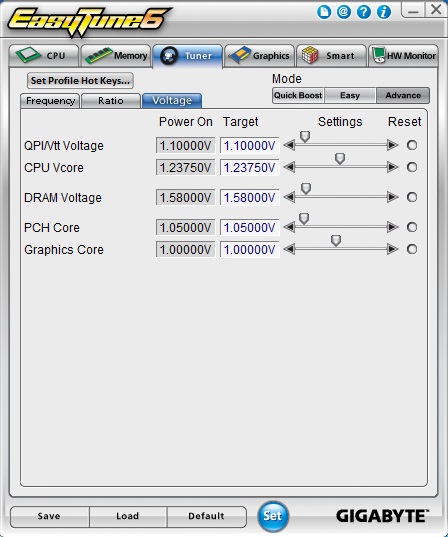Gigabyte Z68X-UD3H-B3 Review
by Brendan van Varik on July 11, 2011 7:01 AM EST- Posted in
- Gigabyte
- Motherboards
- Sandy Bridge
- Z68
Board Features
| Gigabyte Z68X-UD3H-B3 | |
| Market Segment | Performance |
| CPU Interface | LGA 1155 |
| CPU Support | Sandy Bridge i3/i5/i7 |
| Chipset | Z68 |
| Base Clock Frequency | 38.0 MHz to 400.0 MHz in 0.1 MHz intervals |
| DDR3 Memory Speed | 1333 MHz by default, 800-2133 MHz supported |
| Core Voltage | Auto, offset or fixed modes, 0.800 V to 1.800 V in 0.015 V intervals |
| CPU Clock Multiplier | Dependant on CPU |
| DRAM Voltage | Auto, 1.108 V to 2.464 V in 0.007V intervals |
| DRAM Command Rate | Auto, 1T-3T |
| Memory Slots |
Four 240-pin DDR3 DIMM slots in dual-channel Regular unbuffered DDR3 memory Up to 32GB total supported |
| Onboard Graphics |
1x D-Sub port 1x DVI-D port, supporting a maximum resolution of 1920x1200 *The DVI-D port does not support D-Sub connection by adapter. 1x HDMI port, supporting a maximum resolution of 1920x1200 1x DisplayPort, supporting a maximum resolution of 2560x1600p |
| Expansion Slots |
2 x PCI Express 2.0 x16 slots (x16/x0 or x8/x8) 3 x PCI Express 2.0 x1 slot 2 x PCI slots Supports ATI Crossfire Supports NVIDIA SLI |
| Onboard SATA/RAID |
2 x SATA 6.0 Gb/s ports supporting RAID 0/1/5/10 3 x SATA 3.0 Gb/s ports (blue) supporting RAID 0/1/5/10 2 x SATA 6.0 Gb/s ports (white) from Marvell 88SE9172 supporting RAID 0/1 1 x eSATA 3.0 Gb/s port |
| Onboard |
4 x SATA 3Gb/s connectors 4 x SATA 6Gb/s connectors 4 x Fan Headers (1x4-pin, 3x3-pin) 4 x USB 2.0 headers support additional 8 USB 2.0 Ports 1 x Front panel switch/LED header 1 x TPM module connector 1 x USB3.0/2.0 header 1 x IEEE 1394a header 1x SPDIF Out header 1x Serial port header 1 x Firewire/IEEE 1394 header 1 x Front panel audio header 1x Clearing CMOS jumer |
| Onboard LAN | 1 x Realtek RTL8111E chip (10/100/1000 Mbit) |
| Onboard Audio | Realtek ALC889 Codec, 2/4/5.1/7.1-channel, Dolby Home Theater, S/PDIF Out |
| Power Connectors |
24-pin EATX Power connector 8-pin EATX 12V Power connector |
| Fan Headers |
1 x CPU Fan (4-pin) 3 x SYS Fan (3-pin) |
| IO Panel |
1 x PS/2 keyboard/mouse port 1 x D-Sub port 1 x DVI-D port 1 x optical S/PDIF Out connector 1 x HDMI port 1 x DisplayPort 4 x USB 2.0/1.1 ports 1 x IEEE 1394a port 1 x eSATA 3Gb/s connector 2 x USB 3.0/2.0 ports 1 x RJ-45 port 6 x audio jacks (Center/Subwoofer Speaker Out/Rear Speaker Out/Side Speaker Out/Line In/Line Out/Microphone) |
| BIOS |
2 x 32 Mbit flash Use of licensed AWARD BIOS Support for DualBIOS™ PnP 1.0a, DMI 2.0, SM BIOS 2.4, ACPI 1.0b |
| Warranty Period | 3 Years |
Software
EasyTune6 is Gigabyte's take on the monitoring and overclocking software within Windows. When you open the software, the Tuner tab opens by default. It offers three different “Quick Boost” options which are described in greater detail within the overclocking section of this review.

EasyTune6 does pretty much what you’d expect from this kind of software. It tells you everything about your CPU, memory, graphics card(s) as well as providing a hardware monitor and the ability to change your fan profiles.
EasyTune6 allows you to manually set fan profiles within Windows. The default is set at 27% when your CPU is at 20°c and 100% when it reaches 72°c. It increases as the temperature rises in order to try to keep the CPU temperature down. It’s simple really, if the CPU is still getting warmer with increased fan speeds, then the fan isn’t moving enough air so it speeds up more to bring the temperatures down. If all else fails and the CPU reaches 72°c or above, the fan will run at 100%.

When you select the advanced option, you can manually adjust the settings of the two fans that are controlled by the CPU temperature. Unfortunately, you cannot change the speed of the CPU fan and SYS_FAN2 individually - both are controlled by the CPU temperature. SYS_FAN1 and PWR both run at 100%, no matter what. There is no control over those.


You can overclock your system from within Windows. EasyTune6 allows you to change most of the required settings. You can alter the BCLK, DRAM frequency, multiplier and the system voltages.
















70 Comments
View All Comments
DBissett - Monday, July 11, 2011 - link
What is it with using plural verbs following "Gigabyte", as in "Gigabyte have...." and "Gigabyte do....". This sounds atrocious in an otherwise well written article. Verbs should be "Gigabyte has...." and "Gigabyte does...." because "Gigabyte" is a singular noun. Where's the editor?LtGoonRush - Monday, July 11, 2011 - link
Corporations are treated as plural nouns in most English-speaking countries.Death666Angel - Monday, July 11, 2011 - link
Then Anandtech isn't being consistent, because they treat Apple, for example, as a singular entity, see iPad2 and iOS 4.3 reviews ("Apple has...").As a non native English speaker, I agree with DBissett, reading "Gigabyte have..." is not very intuitive and distracts.
Otherwise, nice article. I'm still using a i7 860 and a AMD 5770 and will use those until the 28nm GFX and 22nm CPUs are around.
Snotling - Monday, July 11, 2011 - link
I noticed it too, but "an SSD" is just as bad... its "a SSD"Exodus220 - Monday, July 11, 2011 - link
Actually, you would be incorrect in stating that it should be written "a SSD." The usage of "a" vs "an" is in regards to the beginning vowel sound of a word, not if it begins with a vowel. Since SSD begins with an "es" vowel sound it requires "an" placed before it. Thus, "an SSD" is 100% correct.awaken688 - Monday, July 11, 2011 - link
Yep. 100% correct.roboray - Monday, July 11, 2011 - link
"As a non native English speaker, I agree with DBissett, reading "Gigabyte have..." is not very intuitive and distracts."As a native English speaker, I agree as well. I can count on my fingers the number of times I have seen corporations treated as plural nouns, and it's always a distraction. It makes me suspect that the editor is someone who got their Master's in English without having actually used the language much for anything other than a topic of study. "Proper" or not, it's not common practice, at least in the US.
Jambe - Monday, July 11, 2011 - link
Get over yourself.I like to go all Grammar Nazi from time to time myself, but seriously. This is a trifle.
joshv - Wednesday, July 13, 2011 - link
This is standard British usage. It's just different, it's not incorrect. You will rarely encounter it in writing by American writers, though the British usage is starting to make some beachheads. It's not at all clear to me that or the other way is more proper or correct. The British just interpret corporate entities as representing multiple people - thus plural.DBissett - Monday, July 11, 2011 - link
I disagree. I've been writing in the US for 50 years and the use of singular verbs with corporate names has only recently begun to creep into otherwise good writing. Check any publication you like. Further, AT is very inconsistent in this regard both between and within articles. The responder below points this out. Also, look in this article's summary, where Gigabyte is used with a mixture of singular and plural verbs.